During the seventeenth century, a number of issues in England helped bring about the change from the first (1644) to the second (1689) LBC. Moreover, the Baptist and Presbyterians would be closer in work and deed than today’s American counterparts. Four major events prompted the Second London Baptist Confession to be created in the likeness of its earlier cousin, the Westminster Confession of Faith.
- 1661—the Episcopalians recaptured the machinery and endowments of the Church of England and were bent on achieving uniformity in England and not accepting Presbyterians, nor the WCF-1646.
- 1661–1665—a series of coercive acts forming the Clarendon Code were put into effect, suppressing dissidents, namely Presbyterians, but effecting Baptist as well, and other Congregationalists throughout England.
- 1672—King Charles favored the restoration of Roman Catholicism and issued a Declaration of Indulgence that suspended all penal laws of an ecclesiastical nature against all Protestant dissenters, Presbyterian and Baptist.
- 1673—England’s Parliament passed the Test Act which barred nonconformists from all military and civil offices.
These four key issues motivated the Particular Baptist of London to show agreement with Presbyterians and other Congregationalists through England. They did this by making the Westminster Confession the basis of a new (second) confession of their own. Thus the London Baptist purpose had been clearly stated:
“Our [Baptist] hearty agreement with them [Presbyterian] in that wholesome protestant doctrine, which, with so clear evidence of Scriptures they have asserted.”
One of the most evident “Presbyterian-friendly” areas the Baptist authors saw fit to change in the 1689 Confession can be found in chapter 30 on The Lord’s Supper. No longer was it restricted to scripturally baptized people in the 1689-LBC, as it had been in the 1644-LBC. The assembly writing the second London Baptist Confession saw fit to work with the Calvinistic Presbyterians for the sake of the Protestantism of their time. While there are differences between the London Baptist Confession of 1689 and the Westminster Confession of Faith (see chapters 7, 19–23, 25 of the LBC of 1689), in all they often have more similarities than differences, thus showing their close relationship during the time of the Protestant Reformation.
It should be mentioned, Presbyterians at times make the remark that London Baptists copied their confession. While layout and words are almost identical at times (chapters 1, 9, 16 & 32) there are additions, differences, and sections condensed throughout the whole of the London Baptist Confession of 1689. If you do not agree, you can take a look at a Tabular Comparison of the WCF & 2nd-LBC for yourself.
The Particular Baptists and Calvinism
The London Baptists used the outline of the Westminster for their 1689-LBC because this base was far more complete and better organized than their earlier confession of 1644. It provided a well-established layout for their confession that paved the way for multiple changes. There are a number of differences between the London Baptist Confessions of 1644 and 1689. Sections were added to the 1689 in the areas of marriage, the Scriptures, and the Sabbath, and it contained a stronger emphasis on Calvinism than its predecessor. This emphasis is most evident in the difference of verbiage between the 1644 and 1689 London Confessions dealing with what is called “Calvinistic” doctrines.
Total Depravity
6.2: Our first parents, by this sin, fell from their original righteousness and communion with God, and we in them whereby death came upon all: all becoming dead in sin, and wholly defiled in all the faculties and parts of soul and body.1
Unconditional Election
3.5: Those of mankind that are predestinated to life, God, before the foundation of the world was laid, according to his eternal and immutable purpose, and the secret counsel and good pleasure of his will, hath chosen in Christ unto everlasting glory, out of his mere free grace and love, without any other thing in the creature as a condition or cause moving him thereunto.2
Limited Atonement
3.6: As God hath appointed the elect unto glory, so he hath, by the eternal and most free purpose of his will, foreordained all the means thereunto; wherefore they who are elected, being fallen in Adam, are redeemed by Christ, are effectually called unto faith in Christ, by his Spirit working in due season, are justified, adopted, sanctified, and kept by his power through faith unto salvation; neither are any other redeemed by Christ, or effectually called, justified, adopted, sanctified, and saved, but the elect only.3
Irresistible Grace
15.1: Such of the elect as are converted at riper years, having sometime lived in the state of nature, and therein served divers lusts and pleasures, God in their effectual calling giveth them repentance unto life.4
Perseverance of the Saints
17.1: Those whom God hath accepted in the beloved, effectually called and sanctified by his Spirit, and given the precious faith of his elect unto, can neither totally nor finally fall from the state of grace, but shall certainly persevere therein to the end, and be eternally saved, seeing the gifts and callings of God are without repentance, whence he still begets and nourisheth in them faith, repentance, love, joy, hope, and all the graces of the Spirit unto immortality; and though many storms and floods arise and beat against them, yet they shall never be able to take them off that foundation and rock which by faith they are fastened upon; notwithstanding, through unbelief and the temptations of Satan, the sensible sight of the light and love of God may for a time be clouded and obscured from them, yet he is still the same, and they shall be sure to be kept by the power of God unto salvation, where they shall enjoy their purchased possession, they being engraven upon the palm of his hands, and their names having been written in the book of life from all eternity.5
Connections to Today’s Current Situation: The London Baptist 1689 Confession of Faith’s Influence on the Abstracts of Principles
James Petigru Boyce, often called the Cavalier and Puritan, was a pastor, a university professor, and above all, the founder and first president of Southern Baptist Theological Seminary (SBTS), a seminary of the Southern Baptist Convention (SBC). Boyce more than appreciated Calvinistic theology—he was raised by a mother of Presbyterian descent, and he studied under Archibald Alexander at Princeton Theological Seminary. As Timothy George has stated, “Princeton provided Boyce with a systematic framework in which to cast the Calvinist theology he had imbibed from Basil Manly Sr. and his other Charleston pastors.” After his education at Princeton, Boyce pastored for two years before moving on to teach at Furman University. In 1856, Boyce gave an address titled “Three Changes in Theological Institutions,” which would not only affect where he worked at the time, but also bring about the foundation of Southern Baptist Theological Seminary.
As Boyce made clear during the birth of Southern Baptist Theological Seminary (SBTS), three ideals were essential to building a common theological seminary in the South: The first was openness, creating a seminary for everyone and anyone who was called by God regardless of academic background or social status. The second was excellence—Boyce was intent on establishing an advanced program of theological study that, in its academic rigor, would be comparable to the type of instruction offered at Princeton, Andover, Harvard, and Yale. The third change that Boyce brought to SBTS established a set of mandatory doctrines and a confessional guideline for SBTS’s instructors. Timothy George sheds light on this in his Theologians of the Baptist Tradition.
“The third ideal was confessional identity. Boyce proposed that the seminary be established on a set of doctrinal principles that would provide consistency and direction for the future. This, too, was a radical step in the context of nineteenth-century Baptist life. Newton Theological Institute, the first seminary founded by Baptists in America, had no such confessional guidelines. Nor, indeed, did the Southern Baptist Convention, organized in 1845. However, Boyce firmly believed that it was necessary to protect the seminary from doctrinal erosion. From his student days in New England, Boyce was aware of the recent currents in theology: Unitarianism, Transcendentalism, the New Divinity. In particular, he spoke against the “blasphemous doctrines” of Theodore Parker, who had denied that Christianity was based on a special revelation of God. At the same time he was concerned about populist theologies in the South, and warned against the “twin errors of Campbellism and Arminianism.”
While all three areas of Boyce’s address and vision are true of SBTS today (thanks to Dr. Al Mohler), that is not the case for the SBC. It is not false in the light that it has fallen short of Boyce’s Abstracts of Principles—the SBC was not, in fact, founded on Boyce’s Abstracts of Principles—but the SBC did not follow the examples set before it by its earlier Baptist forerunners (London Baptist in 1689, Philadelphia Baptist in 1742, and New Hampshire Baptist in 1833) in making a confessional theology, which would have given it a denominational foundation. The SBC was finally organized as a convention by 1845, but it had no foundational set of doctrines to follow until 80 years later, in 1925. These have been edited, revised, and added to a number of times throughout the past century, and they have led to the different views within the SBC on salvation, especially in the absence of the SBC doctrines’ earlier Calvinistic brother, the New Hampshire Confession of Faith (1833).
The SBTS still holds to its original confessional standard, maintaining that its professors agree to the same Abstracts of Principles that Boyce meant to define the SBC. As Timothy George points out, “The Abstract of Principles was intentionally modeled on the Philadelphia Confession of Faith, which was based on the Second London Confession, which, in turn, was a Baptist adaptation of the Westminster Confession.” Thus one sees the historical value in taking a look back into his or her church history. Seeing the godly examples, the doctrinal stances, and theological guidelines God has given to His Church brings great value to the Church’s future growth.
For Additional Information
Theologians of the Baptist Tradition, ed. Timothy George and David S. Dockery (Nashville, TN: Broadman & Holman Publishers, 2001).





